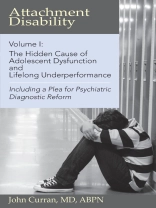Trauma’s lasting aftershock: misunderstood emotional disability
No one is immune from the pain of loss and abandonment. A beloved figure’s death, a betrayal of trust, or abuse can inflict a degree of pain that is seriously traumatic. Those suffering such trauma may react with mistrust and depression, becoming unwilling or unable to reach out to others or accept attention and love. Their learning potential and life performance are impaired and their ability to develop stable relationships is disrupted: this is Attachment Disability.
Unfortunately, contemporary psychiatry minimizes the significance of trauma, leaving many attachment-disabled people misdiagnosed, mismanaged, and enduring unnecessary suffering.
In Attachment Disability, Dr. John Curran, a psychiatrist with decades of private and institutional practice, demonstrates that emotional disability is always trauma related. He draws on professional literature and dozens of case studies to define three types of Attachment Disability: Avoidant, Entangled, and Acting-out. He persuasively advocates a psychiatric management style that avoids making things worse and helps people in pain clarify and accept their trauma and then focus on what they can change.
Dr. Curran concludes with suggestions on how American psychiatry can be invigorated by clearly distinguishing between mental illness and the emotional disability it generates.
Attachment Disability offers an invaluable contribution to the psychiatric profession and the people it seeks to serve.
‘I wish I had this book thirty years ago; I would have made it required reading for every therapist on my staff.’
—Richard Obershaw, AMW, MSW, LICSW; author of the best-selling Cry Until You Laugh: Comforting Guidance for Coping with Grief
Mục lục
Preface
Introduction: Attachment Disability Defined
Part 1: Understanding Attachment Disability
1: Origins of the Idea of Attachment
Part 2: Varieties of Attachment Disability
2: Attachment Avoidance: Three Cases
3: Attachment Entanglement: Four Cases
4: Attachment Acting-out: Three Cases
Part 3: Origins of the Theory of Attachment Disability
5: Early Origins
6: Later Origins
7: More Recent Origins
Part 4: Attachment Disability, Anxiety, and Depression
8: Attachment Disability and Anxiety
9: Attachment Disability and Depression
Part 5: Managing Attachment Disability
10: Management: Strategy and Tactics
11: The First Management Principle: Clarification
12: The Second Management Principle: Acceptance
13: The Third Management Principle: Focus On What Can Be Changed
14: Current Psychiatric Assessment: A Plea for Reform
Notes
Bibliography
Index
Author’s Note: Introducing Volume 2
About the Author












